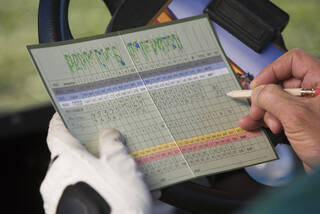Reading a Golf Scorecard in 8 Easy Steps
These 8 tips will help you decode a golf scorecard in no time

Getty Images
A golf scorecard packs a lot of information into a small, 6-by-8-inch card. Knowing the course difficulty, identifying the proper tees for your game, and pinpointing the easiest and most difficult holes at a glance can be a big help to your game, especially on a course that’s new to you.
These eight steps outline everything you need to know on a scorecard and how to use this information to your advantage.
Not all golf scorecards are the same. Some scorecards have more details, some take full advantage of both sides of the card, and some are nothing more than a table for numbers.
There are, however, certain facts you can expect to find on every scorecard.
1. Identify Tee, Yardage and Par Information

Adapted from Getty Images
You can find the golf course’s tees and yardages listed in descending order from top to bottom on the scorecard.
Each tee is noted by its color or symbol and shows each hole’s yardage and par from left to right.
At the end of holes 1 through 9, you can find the total yardage and par for the front nine. After holes 10 through 18 you can find the total par and yardage for the back nine, followed by a final column with the total par and yardage for all 18 holes.
Some golf courses suggest which tees are appropriate for your handicap or typical score range right on the scorecard. For example, a scorecard with black tees that measure a total of 7,120 yards might note those tees are appropriate for players with a handicap of 0 to 5 or players who typically shoot in the 70s or better.
If a scorecard doesn't suggest the appropriate tees for your ability, a good rule of thumb is to multiply your average drive distance by 28, and find the tees that play the closest to that yardage.
2. Local Rules
Before you hit your first shot, we strongly recommend studying the scorecard to find any local rules specific to that particular course.
These are rules specific to a golf course that are extensions or adaptations of a USGA rule.
Knowing the local rules can give you a heads up on out-of-bounds areas, including sneaky internal out-of-bounds, or outline advantageous relief options in specific areas of the course.
There are even golf courses in the Desert Southwest that adopt a local rule which allows a 15th club which is to be used as a “rock club” to hit shots from the desert.
3. Hole Layouts
Some golf courses provide hole layouts on their scorecards, typically at the top of the card above each hole.
If your scorecard on a particular day has hole layouts, take advantage of them. These diagrams often highlight where trouble is that you might not be able to see from the ground level.
However, not every course has hole layouts on the scorecard.
At high-end golf courses, there is usually a yardage book that accompanies the scorecard. The yardage book gives a much more in-depth look at each hole. If you see one in the pro shop, check it out. They're often free.
The other reason you wouldn’t find hole layouts on a scorecard is simply that the cost of printing the cards goes up quite a bit. For smaller, municipal courses having hole layouts on the scorecard is an unneeded expense.
With GPS now available in many golf carts in addition to apps and handheld GPS devices, hole layouts on scorecards are becoming less important.
4. Out, In, Total
After the front nine, the scorecard has a column for “Out.” This column is for your total score on holes 1 through 9. After the back nine, the scorecard has a column for “In.” This is for your total score on holes 10 through 18.
When you hear that a golfer "went out in 34" it means the player shot 34 on the front nine.
The "In" column is for your back nine score. If a player "came in in 38" it means they shot 38 on the back nine, coming into the clubhouse.
Finally, at the end, there is a "Total" column for the sum of your front and back nine scores, your total score.
5. Golf Course Slope & Rating
The golf course rating is a representation of a course's difficulty expressed in the expected score for a scratch golfer. For example, if a course is listed as a par 72, but it’s rated to be fairly difficult, the rating might show up as a 73.2.
On the flip side, if a par 72 course is rated to actually play slightly easier than par, the course rating could be 71.2.
Each set of tees has its own rating based on what a scratch golfer would shoot on that particular setup, and that rating is always printed on the scorecard. Many players might not know that every course also has a bogey rating, the expected score of a bogey golfer. While you can't find this information on the scorecard, you can look it up in the National Course Rating Database.
The course rating is always accompanied by its Slope Rating. The difference between the course rating and the bogey rating is the Slope Rating.
The Slope Rating tells you how proportionately difficult a set of tees are between a scratch golfer and bogey golfer.
Slope ranges from 55 (easiest) to 155 (hardest) and a slope of 113 represents a standard relative difficulty between the two golfers.
Notable courses that have the highest slope rating possible of 155 include the Stadium Course at TPC Sawgrass and Castle Pines Golf Club in Castle Rock, Colo.

Golf Slope Rating Explained in Easy Terms
6. Handicap Rankings
Another important piece of information on the scorecard is each hole’s handicap ranking. On an 18-hole golf course, each hole is ranked 1 through 18 for both men and women.
Generally speaking, the rankings go from the most difficult (No. 1) to the easiest (No. 18) hole on the course, however, there are a couple other factors in play. On an 18-hole course, one side will have all the even-ranked holes and the other will have all the odd-ranked holes. The USGA also tries to avoid starting or finishing with the most difficult holes or grouping them together whenever possible.
If you've ever heard a golf buddy say "I birdied the No. 1-ranked hole" they are referring to the level of difficulty of the accomplishment.
Why rank the difficulty of each hole? The reason is simple, those rankings dictate which holes players give or get handicap strokes.
If you're playing a match against a buddy and you give them four strokes, they will get a stroke on the Nos. 1-4 ranked holes. Since the even and odd ranked holes are grouped together by side, you will give them two strokes per side.
7. Pace of Play
To keep golfers honest with their pace of play, many courses print a prescribed pace of play on the scorecard.
This tells golfers the maximum amount of time it should take their group to play each hole. If your scorecard has this information, pay close attention to how your pace aligns with the prescribed pace, and for everbody's sake, do your best to keep up or beat the prescribed pace.

Pace of Play Techniques: How to Speed Up Your Game
8. Scorer, Attest, Date
After your round, it's time to make it official.
At the very bottom of the scorecard you’ll notice space for a scorer, attest, and date. These can be used in casual rounds of golf, but they are mainly intended for a competition where scoring is being tracked.
In competition, players swap scorecards, meaning Golfer A keeps Golfer B's score, and vice versa. The person who has been holding and writing scores throughout the round signs the cards as the scorer. That individual’s playing partner then attests and signs the card. Lastly, there’s a date section to note the date the round was played.
At any junior or professional golf tournament, players must go to scoring immediately following their round to sign and attest one another’s scorecards before the rounds become official.
Bonus: History, Accolades & Architect
Every course wants to highlight its best features, and the scorecard is a great place to do that, since you look at it for 4-5 hours while you play.
The front of a scorecard usually boasts the golf course’s logo or a picture of its signature hole. The front of the card is also often used to recognize any important history or accolades. For example, if the course has ever hosted a professional tour event or has a national ranking from a major publication, it's likely to be noted on the front.
You can usually find the course architect and the year it opened on the scorecard as well. Sure, this information may not be pertinant to your round or your next shot, but it's a nice quick history lesson that can help you appreciate the courses you play.
The Final Score
If you don’t often look over a golf course’s scorecard, it's a good idea to allow a couple of minutes before your round to do so, especially if you're playing a course you've never played before, or haven't played lately.
You never know what benefits or local knowledge might be lurking in the folds.